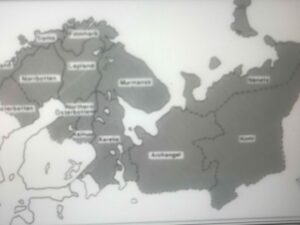I love Finland, where I travelled from Baltic South to the extreme North many times. From the ‘peak’ of Ukkokoli (300m.) I have seen 10000 lakes until Russia and further. I was writing small poetry at the shadow of church of Suomenlinna, in front of the Swedish fortress, I was eating sweet strawberry with cream on the white shores of Savonlinna lake, remembering “The seventh seal” of Bergman. In Lapland, at Akaslompolo, I was hearing an opera among mosquitoes (they continue to compose operas in Finland). In Kirkenes crosspoint of wars among the three Russia, Finland, Germany, I was embarking on famous Hurtigruten ferry to Bergen, along the unforgettable coast of Norway, I was having a small accident with my car because of cellular rings near to Parkano, where I could appreciate the help of Finnish people magically appeared with six cars from an empty forest and the kindness of a young doctor controlling my neck. It was the only country where touristic indications were also in Russian language. Notwithstanding the transferring of 50% of GDP products in SSSR in 50’s, as reparation for the lost war, the diplomatic actions of Finland were balancing the two sides of Cold War, keeping opened information channels and business opportunities. Like Italian policy, but more transparent because not in OTAN organisation, but neutral like the success countries Switzerland and Austria. Declaring its independence in 1917, Finland established a model for other polities of tsarist Russia to do likewise. Shortly thereafter, other subaltern nations of the Romanov imperium – including Estonia, Latvia, Lithuania, and Poland – would follow, alongside other failed attempts at state-building that were short-circuited by the Bolsheviks (e.g. Ukraine, Georgia, and the Idel-Ural State). After its bloody Red-White civil war (1918), Finland – as a ‘border state’ with the new Soviet regime – became the northern bulwark of a geopolitical bloc known by its French appellation, the cordon sanitaire (protective corridor). This zone served to separate the ‘politically diseased’ states of revanchist Germany and Bolshevik Russia, later known as the Union of Soviet Socialist Republics (SSSR). Possessing an Arctic coastline before World War II and territory on the threshold of Russia’s former capital Leningrad, Finland’s spatial situation neatly served western European interests, which included preventing the revolutionary ‘contagion’ spreading to the working classes in Birmingham, Rotterdam, and Paris, while also establishing a new market for goods produced in these industrial cities. Geopolitics began in Norden. Pioneered by the Swedish geographer Rudolf Kjellén with his 1916 text Staten som livsform (translated into German a year later as Der Staat also Lebenform), Geopolitikemerged as a distinct discipline in the early twentieth century. Geopolitical thinking shaped much of the twentieth century, introducing terms such as the World-Island, Lebensraum, and Rimland Theory. So geopolitical tradition remains very high and the positioning of Finland, through the Second World War, where it was allied with Germany against Russia and then after signing armistice, allied of Russia against Germany in the North, kept in any case the objective to balance East and West, including the entering in EU without problems with Russia. Now the historical choice after Ucraine war, to enter in OTAN and transform an opened border in a new Iron Curtain. It’s a challenging decision for a small, clever and rich country, it seems more a tactic one than a strategic one, because geography has its constraints and no more than twenty years ago Northern Europe was discussing about an integration with territories of Northern Russia (see map 2002 Sami Moisio), with similar characters and a lot of natural resources. People are speaking of war, but surely forests and lake will not move like those of Macbeth to assault their colleagues on the other side of the border.
In Finland forests and lakes remain peaceful
Share:

HUNGARY, REMEMBERING NICE DAYS…
Massimo Merlino
08/07/2024
I remember the impression of the Hungarian Miklos Jancso movie “Horse Army”, according to the Italian title from

WOKE CULTURE DISEMBARKS IN VENICE
Massimo Merlino
04/06/2024
Traditionally I try to photograph the status of world through Architecture Biennale, but this year I visited the

Ottoman octopus move its legs.
Massimo Merlino
12/04/2024
In October 2017 I was writing a contribution on Turkey geopolitics, you can find it in this blog,

USA victory: tactic or strategic?
Massimo Merlino
02/04/2024
USA successful victory in present European war seems un-doubtful. They obtained three main objectives until now: All the
